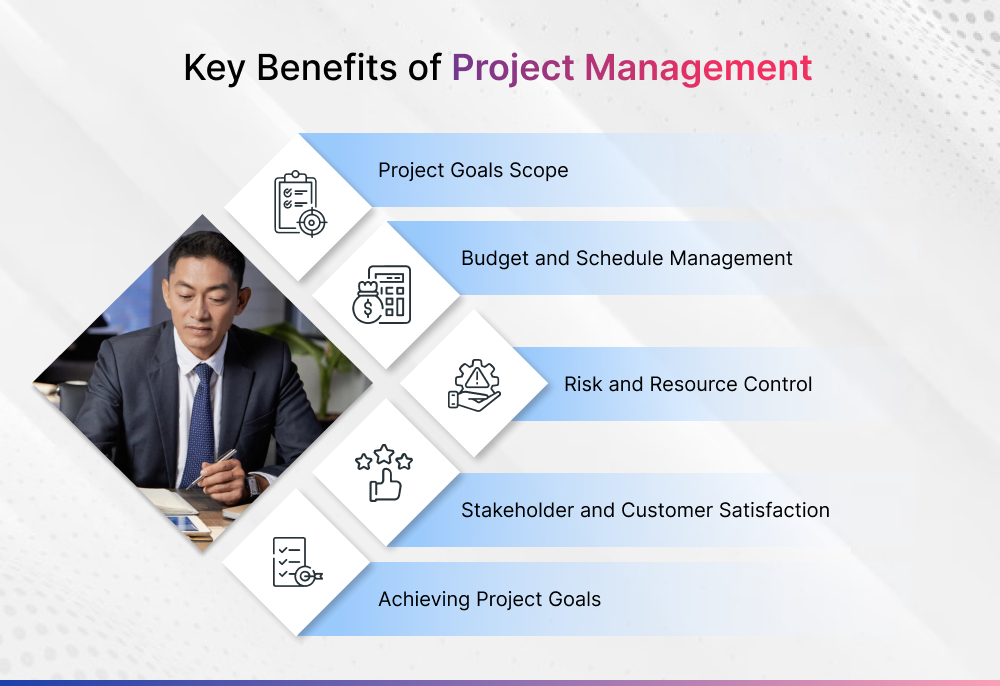
PMI Talent Triangle has quietly become a differentiator among project managers who lead with more than delivery. The ones shaping strategy, aligning teams to outcomes, and earning trust at the leadership table aren’t just relying on tools and timelines; they’re using this model to evolve how they grow, decide, and lead.
Those who use the Talent Triangle well aren’t applying it as a framework; they’re using it as a lens. A lens to evaluate how they lead, how they make decisions, and how they grow in relevance across the business. It’s a way to stay intentional about the skills that matter now: adaptability, influence, and strategic thinking.
Table Of Contents
- The Evolution of Project Management Excellence
- Understanding the PMI Talent Triangle Framework
- The ROI of Talent Triangle Implementation
- Real-World Case Study
- Your Personal Action Plan: Mastering the PMI Talent Triangle Step-by-Step
- Conclusion
In this blog, we’ll explore how experienced project professionals are using the Talent Triangle to evolve their capabilities—and how you can use it to stay ahead, stay aligned, and lead with greater impact.
The Evolution of Project Management Excellence
The PMI Talent Triangle is more than just a competency model; it’s a strategic enabler for project professionals navigating volatile business environments. In an era where business moves faster than ever, project managers are expected to do more than meet deadlines or manage scope. They must lead with influence, think commercially, and stay ahead of evolving methodologies and technologies.
The PMI Talent Triangle addresses this head-on by emphasizing a balanced mastery of technical project management, power skills, and business acumen. This triad is not just a checklist; it’s a roadmap for professionals who want to lead change, drive results, and remain relevant.
By helping professionals expand their capabilities beyond traditional methods, the PMI Talent Triangle empowers them to become catalysts for business success, bringing not just execution but insight, leadership, and strategic thinking to the table.
Understanding the PMI Talent Triangle Framework
The PMI Talent Triangle is more than a mindset shift; it’s a practical framework that defines the ideal skill set for modern project professionals. Introduced by the Project Management Institute (PMI), the framework acknowledges that project success now requires more than just technical expertise. It requires a balanced integration of three competency areas:
The Three Components of the Talent Triangle:
1. Ways of Working (formerly Technical Project Management):
Skills, certifications, and tools to deliver outcomes—Agile, Waterfall, Scrum, Kanban, PMBOK, risk management, scheduling, and beyond.
2. Power Skills (formerly Leadership):
Human-centered abilities, such as communication, empathy, collaboration, conflict resolution, and emotional intelligence, are essential for building trust and guiding teams through complexity.
3. Business Acumen (formerly Strategic & Business Management):
Understanding of the broader organizational and industry landscape, financial literacy, market awareness, strategy alignment, and data-driven decision-making.
Together, these three dimensions reflect PMI’s belief that successful project leaders must be adaptable, influential, and strategically grounded.
Evolution of the Talent Triangle: Key Milestones
| Year | Milestone |
| 2015 | PMI introduces the Talent Triangle as part of its Continuing Certification Requirements, focusing on three key areas: Technical Project Management, Leadership, and Strategic & Business Management. |
| 2022 | Framework updated to reflect new workplace demands: hybrid methodologies, digital transformation, and leadership for change. |
| 2025 | Latest PMI research confirms the Talent Triangle’s effectiveness in boosting project success and advancing careers. |
The PMI Talent Triangle provides a straightforward yet powerful framework for developing this multifaceted skill set.
1. Ways of Working: The How of Project Success
At the heart of every successful project is one defining skill: the ability to choose the right way to deliver it.
Gone are the days when one method – Agile, Waterfall, or anything in between- could fit all. Today, what separates a reactive manager from a strategic project leader is the ability to adapt their approach based on the project’s needs, the team’s needs, and the business’s needs.
The Ways of Working domain reflects this reality. Yes, it covers the technical foundations of project management, but more than that, it’s about developing the judgment to decide how to get things done. It’s not about mastering one method. It’s about knowing when to use what and why.
How to Choose the Right Approach?
Think of the Ways of Working domain as your strategic toolkit – not just a collection of methods, but a lens for making informed delivery choices. Every project presents different constraints: some require structure, while others demand speed or space for experimentation. What matters is your ability to assess the environment and select the most effective path. Whether it’s a fully predictive plan, an Agile sprint cycle, or a tailored hybrid, this domain equips you to shift gears with confidence and lead projects in a way that matches their real-world complexity.
| Approach | Best Used When | What It Involves |
| Predictive (Waterfall) | The scope is clear, outcomes are fixed, and risk is low | Scheduling tools, detailed planning, earned value tracking |
| Agile | Priorities may shift, and speed and feedback are essential | Scrum, Kanban, iterative sprints, team-led workflows |
| Hybrid | Some aspects need structure, others need flexibility | Disciplined Agile, SAFe, combining phases with iterations |
| Emerging Practices | Innovation is the goal, or the path forward isn’t fully defined | Design Thinking, Lean Startup, DevOps, experimentation |
The trend to watch
- 60% of project managers use the Hybrid project delivery approach.
- 89% of high-performing organizations now use hybrid project management approaches
Rather than sticking to one style, experienced project leaders read the room, assess the landscape, and shape their delivery model accordingly. That’s what makes this domain essential, not just technical skills but the ability to apply them with purpose.
2. Power Skills: The Human Advantage
“It wasn’t the plan that saved the project. It was the trust the team had in each other.”
Ask any experienced project leader, and you’ll hear a similar truth – projects succeed not just because of timelines, tools, or methods but because of people. And how well they work together. This is the essence of Power Skills – the human-centered capabilities that bring structure to life and keep teams moving, especially when pressure hits.
Previously labeled “soft skills,” PMI intentionally redefined this domain as Power Skills to reflect their critical role in leading modern projects. In hybrid environments, it’s these abilities that turn strategy into progress and resistance into alignment.
The Human Leverage Points: What Great Project Leaders Rely On
Clarity
Projects succeed when communication is intentional, and understanding is mutual. Clear direction and active listening prevent the missteps that derail even the best-laid plans.
- Purposeful Communication
- Active Listening
Connection
Trust isn’t built into dashboards; it’s built into moments. Great leaders read the room, resolve tension before it escalates, and create psychological safety so teams can stay focused and honest.
- Emotional Intelligence
- Conflict Navigation
- Influence through Trust
Coaching
Change is constant. What sets leaders apart is their ability to guide others through it. The best project managers don’t just manage, they mentor, elevate, and align people with purpose.
- Mentorship & Feedback
- Change Leadership
Why Power Skills Matter More Than Ever?
Power Skills don’t just shape how teams interact; they shape how projects perform.
Organizations that prioritize communication, collaboration, and emotional intelligence report a 72% success rate in meeting business goals, compared to just 65% for those that don’t. That’s not a small difference; it’s a reflection of how alignment, trust, and shared understanding translate directly into outcomes.
The impact extends to project execution as well. When teams are equipped with strong interpersonal capabilities, they experience less scope creep – 28% versus 40%. Why? Better conversations lead to clearer expectations, faster resolutions, and fewer surprises along the way.
Even in failure, the presence of strong Power Skills helps soften the blow. Organizations that develop these human-centered abilities see lower budget losses when projects fail – 17% compared to 25%. It’s not just about avoiding mistakes; it’s about building the resilience to recover when things go off track.
The Missed Opportunity Most Organizations Overlook
Yet, despite the clear impact, only 25% of training budgets are allocated to developing Power Skills.
That means three out of four organizations are underinvesting in the very skills that reduce project risk, improve delivery, and strengthen team performance. While certifications and technical tools get the spotlight, it’s the ability to communicate, lead, and adapt that often determines whether a project succeeds or struggles.
For forward-thinking organizations, this gap represents a clear advantage. Those who prioritize Power Skills aren’t just building better teams; they’re building a long-term edge in how they deliver outcomes, manage change, and lead through uncertainty.
3. Business Acumen: From Execution to Strategy
Would your executive team know why your project matters? Project managers today are expected to do far more than deliver on scope and schedule. They’re expected to think like business leaders, understanding strategy, finances, risks, and market dynamics and ensuring that every project they lead contributes to broader business objectives.
That’s what the Business Acumen domain of the PMI Talent Triangle represents: the shift from execution to strategic influence.
Business acumen begins with the ability to connect project work to financial outcomes, knowing the difference between CAPEX and OPEX, understanding ROI, and being able to interpret key metrics like cash flow or margins.
This is where project managers think like CFOs. They don’t just report cost performance but interpret financial data to guide trade-offs, justify investments, and model business impact. Reading a balance sheet or a profit margin is no longer optional, it’s how you earn your seat at the table.
But business fluency goes beyond numbers. It’s about recognising how shifting market conditions, regulatory changes, customer expectations, or internal priorities influence the way and why decisions are made.
Strategic project leaders speak like strategists. They tie deliverables back to business outcomes, articulate how initiatives support growth or mitigate risk, and communicate in terms that resonate with executives, not just project teams. They don’t just say what is being done; they explain why it matters to the business.
They also move like generalists, working fluidly across functions. Whether it’s marketing, finance, IT, or compliance, they anticipate ripple effects, align stakeholders from different departments, and make decisions that serve enterprise-level goals, not just project milestones.
Project managers who embrace this mindset know how to align deliverables with company strategy, frame their decisions in business terms, and communicate the “why” behind their work to C-suite leaders and stakeholders. They build credibility by contributing to conversations about growth, risk, and competitive advantage, not just deadlines.
They also navigate horizontally, working across departments, anticipating ripple effects, and making decisions that serve the whole organization, not just a single milestone.
The Business Impact Is Clear
According to PMI:
- Project professionals with strong business acumen achieve 83% of their project goals, compared to 78% for those without.
- They also experience lower project failure rates and are more effective at aligning with organizational goals.
- Despite this, only 18% of project managers demonstrate both strategic thinking and strong business understanding, revealing a significant gap in the profession.
This contrast shows that business acumen isn’t optional anymore; it’s a defining trait of future-ready project leaders.
This gap isn’t just academic; it’s performance-based. Teams led by business-savvy PMs make sharper decisions, manage resources more effectively, and are better positioned to turn projects into lasting business value.
How to Build Business Acumen?
Stay informed on industry trends and organizational strategy
Business environments evolve rapidly, and project managers who stay updated are better equipped to lead with relevance. Following market trends, analyzing competitor actions, and understanding your organization’s long-term vision can significantly enhance the quality of your decisions. Courses like the PMP Certification Course and PRINCE2 Foundation & Practitioner Certification can provide structured frameworks for aligning project delivery with enterprise strategy.
Learn to interpret financial reports, KPIs, and market data
Strong business acumen requires more than just intuition, it demands fluency in numbers. Project professionals who can read financial statements, understand KPIs, and assess ROI are better positioned to influence executive decisions. If you’re looking to strengthen these skills, the Business Analysis Foundation and Practitioner Certification offers practical insights into cost-benefit analysis, financial metrics, and value-driven project planning.
Engage with cross-functional teams to broaden your perspective
Successful project outcomes often depend on how well the project integrates with sales, finance, marketing, and operations. Building relationships across these departments helps you anticipate interdependencies, uncover risks, and ensure your project stays aligned with broader business needs. Training in Change Management Foundation and Practitioner Certification can also prepare you to navigate cross-functional dynamics and lead organizational transitions with greater confidence.
Ask not only “how” to deliver but also “why” the project matters to the business
Every project exists for a strategic reason. Understanding the business case, the customer impact, and the competitive value your project delivers allows you to lead with purpose. For early-career professionals, the CAPM Exam Prep Course or Project Management Fundamentals Training Course can help develop this mindset from the ground up, bridging tactical execution with strategic awareness.
The ROI of Talent Triangle Implementation
Developing strengths across the PMI Talent Triangle isn’t just good practice; it delivers tangible results for both organizations and individuals. By investing in all three domains – Ways of Working, Power Skills, and Business Acumen, project professionals and the organizations they serve see measurable improvements in project outcomes, financial performance, and career advancement.
Organizational Benefits
| Organizational Performance Metrics | Everyone Else | High Business Acumen |
| Customer Satisfaction | 66% | 83% |
| Quality of Work | 61% | 78% |
| Adherence to Budget | 57% | 77% |
| Alignment to Strategy | 48% | 65% |
| Operational Efficiencies | 45% | 65% |
| Risk Management Indicators | 36% | 62% |
| Cost Savings | 43% | 62% |
| Adoption of Tools | 38% | 58% |
| Financial Measures | 33% | 57% |
| Regulatory Compliance Indicators | 28% | 52% |
Source: PMI
These metrics capture the hard business benefits that matter most to organizations – improved delivery, cost control, quality, compliance, and strategic alignment.
Individual Career Gains: Your Competitive Edge
For individual project managers, mastering the Talent Triangle translates into accelerated career growth, a stronger professional reputation, and increased earning potential.
Where Talent Triangle Leaders Stand Out?
Leaders who actively apply the PMI Talent Triangle framework consistently outperform their peers, not only in delivery metrics but also in strategic impact, innovation adoption, and team culture. Here’s how:
Quality of Work
High performers report a 78% project quality success rate, compared to a 61% average across the industry.
This isn’t just about technical correctness; it’s about delivering outcomes that meet stakeholder expectations, regulatory standards, and customer satisfaction benchmarks. Project managers who master the Ways of Working domain are more adept at choosing the right methodologies, managing complexity, and ensuring consistent quality from planning to execution.
Alignment to Strategy
Talent Triangle-driven leaders see a 65% success rate in aligning projects to organizational strategy versus 48% for others.
This reflects their strength in Business Acumen, they understand corporate priorities, read market signals, and position their projects to support revenue growth, digital transformation, or operational efficiency. This kind of alignment is often what sets high-potential project managers apart in the eyes of executive leadership.
Adoption of Tools and Innovation
Those proficient in emerging practices and modern toolsets show a 58% success rate in adopting new methods, a clear edge over less adaptive peers.
This adaptability stems from both technical versatility and a growth mindset. Whether implementing hybrid delivery, integrating AI-driven PM tools, or championing Agile transformation, these leaders thrive in change-heavy environments, hallmarks of strong Ways of Working.
Employee and Team Satisfaction
Leaders who focus on interpersonal connection and psychological safety achieve 49% higher team satisfaction, compared to just 26% otherwise.
This speaks directly to their Power Skills, especially in communication, empathy, and collaborative leadership. High-performing project managers don’t just manage people; they inspire them, creating environments where teams feel valued, heard, and motivated.
Driving Cultural Shifts and ESG Impact
Project managers committed to purpose-driven leadership contribute to a 19% success rate in cultural transformation and a 25% improvement in ESG-related outcomes.
These numbers reflect leadership beyond the task list, where emotional intelligence, ethical decision-making, and influence are used to shift behaviors, foster inclusion, and drive projects that align with environmental and social priorities. It’s a rising area where Power Skills and Business Acumen intersect.
Source: PMI
Developing balanced skills across the Talent Triangle not only makes you a better project manager but also positions you as a strategic leader ready to take on higher roles with greater influence.
Real-World Case Study
Successful projects, whether in cutting-edge technology or environmental sustainability, require more than technical execution. They demand the integration of Ways of Working, Power Skills, and Business Acumen to achieve lasting impact. Here is a powerful, real-world example that brings the PMI Talent Triangle to life.
SpaceX Starship Development Project
The SpaceX Starship project aims to create the world’s first fully reusable spacecraft capable of carrying humans to Mars and beyond. It represents not just an engineering challenge but a bold strategic vision to transform space travel.
Ways of Working
- The project thrives on rapid prototyping and iterative testing, building, launching, learning, and refining at an unprecedented pace.
- This Agile-inspired approach allows continuous adaptation to technical challenges and accelerates innovation.
Power Skills
- Managing complex partnerships with government bodies (e.g., FAA regulations) and private investors demands exceptional negotiation, communication, and leadership.
- The project team must navigate safety concerns, regulatory hurdles, and public scrutiny, skills rooted in empathy, influence, and problem-solving.
Business Acumen
- The strategic ambition to make space travel affordable, scalable, and sustainable aligns with strong market awareness and disruptive innovation.
- The project connects to broader organizational goals, including advancing clean energy and manufacturing through SpaceX’s sister companies.
Key Outcome
SpaceX’s approach has dramatically reduced costs per launch and positioned the company at the forefront of the commercial space industry, proving the power of integrated project leadership.
Your Personal Action Plan: Mastering the PMI Talent Triangle Step-by-Step
Understanding the PMI Talent Triangle is a critical step, but what matters most is how you act on it. Whether you’re early in your career or transitioning into a leadership role, this three-phase roadmap will help you progressively build mastery across Ways of Working, Power Skills, and Business Acumen, turning knowledge into performance.
Phase 1: Build Clarity and Intent (Next 30 Days)
This is your foundation phase. The goal is to assess where you stand and create a focused path forward.
1. Conduct a Personal Skills Audit
Take a structured look at your current strengths and gaps in each domain. Reflect on questions like:
- Do I adapt my project delivery approach based on context?
- How confident am I in resolving conflicts or influencing decisions?
- Can I explain my project’s business value in strategic terms?
Use PMI’s free self-assessment tools or create a simple table to rate yourself across scenarios you’ve encountered recently.
2. Create a Visual Skills Map
Translate your self-assessment into a simple visual color code or rank each domain (strong, moderate, needs improvement). This makes prioritization easier and more actionable.
3. Choose One Focus Area
Resist the urge to improve everything at once. Instead, select the domain that:
- Limits your performance today or
- Offers the most immediate ROI for your role or next promotion
Example: If your projects are often derailed due to poor communication, Power Skills should take priority.
4. Build Your Learning Stack
Identify one course, podcast, or book and one practical opportunity to grow that domain. Don’t collect resources; curate with intent.
Suggested resources (based on domain):
- Ways of Working: Agile or hybrid methodologies certification (e.g., PMI-ACP)
- Power Skills: Training in stakeholder management, change leadership, or coaching
- Business Acumen: Courses on financial KPIs, strategy, or product management
Phase 2: Apply and Experiment (Next 60–90 Days)
Now, shift from planning to doing. This is where capabilities become habits.
1. Implement Micro-Experiments
Test new behaviors in your current projects. For instance:
- Try a hybrid model in a mid-sized project with overlapping stakeholder needs
- Replace slide decks with storytelling and visual thinking in stakeholder meetings
- Connect your status updates to business outcomes, not just task progress
Small, focused experiments reduce risk while helping you build confidence.
2. Track Real Feedback
Don’t just hope it’s working, ask. Check-in with colleagues or mentors:
- “Did the new format help clarify priorities?”
- “Was that conversation more engaging or outcome-oriented?”
Document what worked and what needs adjusting. Over time, this builds intuition and strategic judgment.
3. Earn Purposeful PDUs
Use your continuing education hours (PDUs) not as a requirement but as a tool for growth. For instance, if Business Acumen is your focus, choose PDUs that teach financial interpretation, strategic thinking, or value-based prioritization.
4. Reflect Biweekly
Every two weeks, jot down key insights:
- What did I try?
- What was the result?
- What should I double down on or stop?
This cadence reinforces learning and keeps you accountable.
Phase 3: Expand Your Impact (Next 6–12 Months)
At this stage, your development should begin influencing your team, cross-functional initiatives, and even leadership visibility.
1. Pursue Stretch Projects
Look for work that challenges you across all three domains. Examples include:
- Leading a digital transformation initiative
- Managing a project with ESG or compliance goals
- Coordinating across regions or departments with diverse stakeholders
These contexts test and strengthen your adaptability, leadership, and business thinking.
2. Mentor or Teach What You’ve Learned
Offer to mentor a junior project manager or present a short session on what you’ve been applying. Teaching builds deeper understanding and positions you as a leader.
3. Translate Outcomes into Strategic Language
Frame your project updates in leadership terms:
- “This initiative helped us save $120,000 in recurring costs and improved customer turnaround by 20%.”
- “Our hybrid rollout reduced project risk and accelerated team onboarding across three regions.”
The ability to speak this language is a hallmark of strategic leadership.
4. Consider Advanced Credentials or Executive Education
Once your foundation is solid, reinforce it with formal development:
- PMI-ACP® for agile fluency
- PgMP® for program-level governance
- Strategic business or finance courses to deepen your impact
Conclusion
The PMI Talent Triangle is more than a framework; it’s a blueprint for becoming the kind of project leader organizations need today. By developing a balanced mix of Ways of Working, Power Skills, and Business Acumen, you can evolve from managing tasks to driving real business value.
Project professionals who embrace this well-rounded approach stand out, earning greater trust, faster career progression, and the ability to lead complex, high-impact initiatives.
If you’re ready to take the next step in your project management journey. In that case, Invensis Learning offers industry-leading PMI-aligned Project Management Certificate Courses to help you build the skills that matter and advance your career with confidence.





















